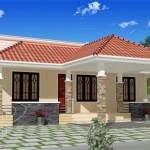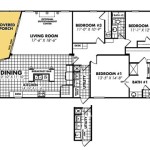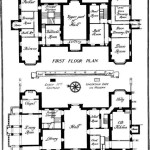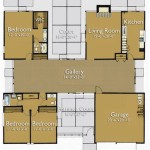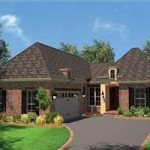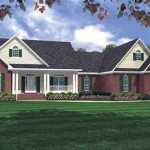House Plans For 3 Bedroom Homes: A Comprehensive Guide
Three-bedroom homes are a popular choice for a wide range of homeowners, from small families to couples seeking extra space for guests or a home office. The versatility of this house size allows for comfortable living without the burden of excessive square footage. Choosing the right house plan is crucial to maximize the functionality and appeal of a three-bedroom home. This article explores various aspects relating to house plans for three-bedroom homes, focusing on design considerations, common layouts, and factors influencing the overall cost and livability.
When considering a three-bedroom house plan, several key elements warrant careful attention. These include the size and layout of the bedrooms, the arrangement of common areas like the living room and kitchen, the presence of amenities such as a garage or patio, and the overall architectural style. A well-designed plan will effectively balance these factors to create a comfortable and functional living space that meets the specific needs and preferences of the occupants.
Key Considerations for Designing a 3-Bedroom Home
Designing a three-bedroom home requires a thoughtful approach, taking into account the needs and lifestyle of the intended occupants. Several key factors influence the overall design and functionality of the house.
Space Optimization: Maximizing the available space is paramount, especially in smaller three-bedroom homes. Open floor plans that combine the living room, dining area, and kitchen can create a sense of spaciousness and improve traffic flow. Strategic placement of windows and doors can also enhance natural light and ventilation, making the home feel brighter and more inviting. Utilizing vertical space through features like vaulted ceilings or loft areas can further contribute to the perception of greater roominess.
Bedroom Layout and Functionality: The bedroom layout should prioritize comfort and privacy. The master bedroom is typically larger and may include a private bathroom and walk-in closet. Secondary bedrooms should be adequately sized to accommodate a bed, desk, and storage space. The placement of bedrooms relative to each other and to common areas is important for noise control and privacy. Consider separating the master bedroom from the other bedrooms to create a more private retreat. Also, ensure that closets are appropriately sized and well-organized to maximize storage capacity.
Bathroom Placement and Design: The number and placement of bathrooms are key considerations. A master bathroom is generally considered essential, while a shared bathroom for the secondary bedrooms is standard. A half-bathroom near the living area can also be a convenient addition. The bathroom design should prioritize functionality and ease of use. Consider features like walk-in showers, double sinks, and ample storage space. Natural light and ventilation are also important considerations for creating a comfortable and healthy bathroom environment.
Kitchen Design and Efficiency: The kitchen is often the heart of the home, and its design should reflect the homeowner's cooking habits and lifestyle. Consider the placement of appliances, the amount of counter space, and the availability of storage. A well-designed kitchen will incorporate a work triangle that optimizes efficiency and minimizes unnecessary steps. Features like a kitchen island or breakfast bar can provide additional workspace and seating. Adequate lighting and ventilation are also crucial for creating a safe and comfortable cooking environment.
Storage Solutions: Ample storage is essential for maintaining an organized and clutter-free home. In addition to bedroom closets, consider incorporating storage solutions throughout the house, such as built-in shelves, cabinets, and pantries. Utilizing under-stair space or attic areas for storage can also be a practical way to maximize the available space. A well-designed storage plan will help to keep the home tidy and organized, enhancing its overall livability.
Accessibility and Universal Design: Designing a home that is accessible to people of all ages and abilities is becoming increasingly important. Consider incorporating features like wider doorways, ramps, and grab bars in bathrooms. Universal design principles aim to create a home that is functional and comfortable for everyone, regardless of their physical limitations. These features can also add value to the home and make it more appealing to a wider range of potential buyers.
Common 3-Bedroom House Plan Layouts
Several common layouts cater to different needs and preferences. Understanding these layouts can assist in choosing the one that best suits individual requirements.
Ranch-Style Layout: Ranch-style homes are characterized by their single-story design and open floor plans. This layout is ideal for those who prefer single-level living and easy accessibility. Ranch-style homes typically feature a long, low profile and a simple, functional design. The bedrooms are often located on one side of the house, while the living areas are on the other. This layout is well-suited for families with young children or elderly individuals who may have difficulty navigating stairs.
Two-Story Layout: Two-story homes offer more living space on a smaller footprint. This layout is ideal for those who want to maximize their land usage and create a more distinct separation between living areas and bedrooms. Typically, the ground floor houses the living room, kitchen, and dining area, while the bedrooms are located on the upper floor. This layout can offer greater privacy and noise control, as the bedrooms are separated from the main living areas.
Split-Level Layout: Split-level homes feature multiple levels connected by short sets of stairs. This layout can create a unique and dynamic living space, with different levels designated for different purposes. Typically, one level houses the living room and kitchen, while another level houses the bedrooms. A third level may be used for a recreation room or home office. Split-level homes can be a good option for those who want to separate different areas of the home and create a more visually interesting design.
Open Concept Layout: Open concept layouts are characterized by the absence of walls separating the living room, dining area, and kitchen. This layout creates a sense of spaciousness and promotes social interaction. Open concept layouts are ideal for those who enjoy entertaining or who want to create a more informal and relaxed living environment. However, open concept layouts can also be more challenging to heat and cool, and noise can travel more easily throughout the home.
Factors Influencing the Cost of a 3-Bedroom House
The cost of building a three-bedroom home can vary significantly depending on several factors. A thorough understanding of these factors is essential for creating a realistic budget and making informed decisions throughout the building process.
Square Footage: The overall square footage of the house is a primary driver of cost. Larger homes require more materials and labor, resulting in higher construction expenses. Carefully consider the size of each room and prioritize essential spaces to minimize unnecessary square footage.
Materials and Finishes: The choice of building materials and finishes can significantly impact the cost of the house. High-end materials such as hardwood flooring, granite countertops, and custom cabinetry will increase the overall expense. Selecting more affordable alternatives without sacrificing quality can help to control costs. Consider using laminate flooring, quartz countertops, and stock cabinetry to save money. It's crucial to strike a balance between aesthetics and affordability.
Location: Building costs can vary significantly depending on the location of the property. Labor costs, material prices, and permitting fees can differ from one region to another. Conducting thorough research on local building costs is essential for creating an accurate budget. Rural areas may have lower labor costs but higher material transportation costs, while urban areas may have higher labor costs but easier access to materials.
Complexity of Design: Intricate architectural designs with complex rooflines, custom features, and non-standard layouts will generally be more expensive to build. Simple, straightforward designs are typically more cost-effective. Opting for a simpler design with minimal ornamentation can help to reduce construction costs. Consider focusing on essential features and prioritizing functionality over elaborate aesthetics.
Labor Costs: Labor costs represent a significant portion of the overall construction budget. The availability of skilled labor and the prevailing wage rates in the area can influence these costs. Obtain multiple bids from qualified contractors to ensure competitive pricing. Carefully vet contractors and choose one with a proven track record and a reputation for quality workmanship.
Permitting Fees and Inspections: Building permits and inspections are required by local authorities to ensure compliance with building codes and safety regulations. These fees can vary depending on the jurisdiction and the scope of the project. Factor these costs into the overall budget. Failing to obtain the necessary permits can result in fines and delays.
Site Preparation: The condition of the building site can also impact the cost of construction. Clearing vegetation, grading the land, and addressing soil issues can add to the overall expense. Conducting a thorough site assessment before beginning construction is essential for identifying potential challenges and mitigating risks. Addressing these issues early in the process can prevent costly delays and unforeseen expenses.

Sample 3 Bedroom House Plans Unleashing Me Small Min On Info Simple Bed Bungalow Floor Plan With Loft

3 Bed House Plans And Home Designs Wide Bay Homes Hervey

Three Bedroom Home Designs G J Gardner Homes

3 Bedroom Apartment House Plans Three Plan Small Design Home

3 Bed House Plans And Home Designs Wide Bay Homes Hervey

3 Bedroom House Plan Examples

Popular And Stylish 3 Bedroom Floorplans Plans We Love Blog Homeplans Com

3 Bedroom Contemporary Home Design Pinoy House Designs Plans Bungalow Floor

Three Bedroom Home Designs G J Gardner Homes

3 Bedroom House Plans Modern Country More Monster

